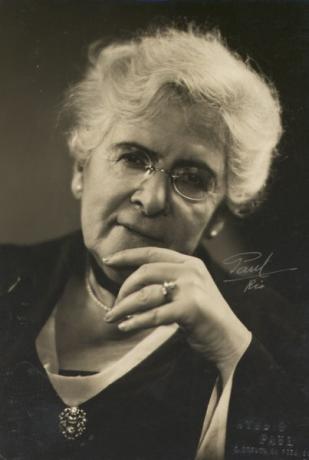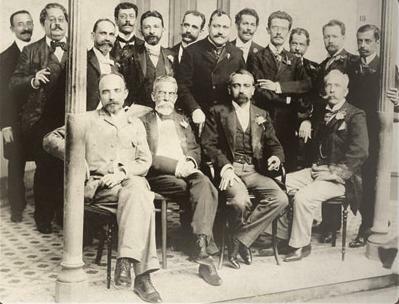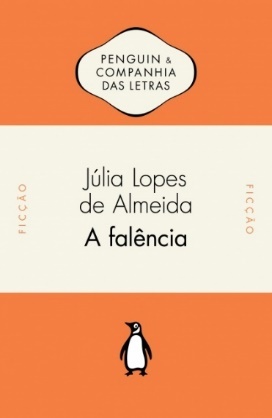Julia Lopes de Almeida, Brazilian writer, was born in September 24, 1862, in Rio de Janeiro. As a child, she moved with her family to Campinas. In 1886, she traveled to Portugal. In that country, she married the Portuguese writer Filinto de Almeida (1857-1945) and published her first book — Traces and Illuminations. In Brazil, she wrote for several periodicals, an unusual activity for women at the time, and was the only woman among the creators of the Brazilian Academy of Letters, despite the fact that she was prevented from occupying a chair in this institution.
considered a writer with advanced ideas for her time, as she defended the abolition of slavery, the republic, divorce, formal education for women and civil rights, Júlia Lopes de Almeida is associated with realism and to thenaturalism. Therefore, her best-known work — bankruptcy (1901) - is marked by objectivity, criticism of Brazilian society, thematic of adultery and determinism. Thus, the short story writer, novelist, chronicler and playwright
had relative success in his time, before pass away inMay 30, 1934, in Rio de Janeiro.Read too: Francisca Júlia — a poetess of Brazilian Parnassianism
Biography
Julia Lopes de Almeida, daughter of rich and cultured Portuguese, was born in September 24, 1862, in Rio de Janeiro. However, when she was still a child, she and her family moved to a farm in Campinas, in the state of São Paulo. The writer received a liberal education and, with her father's support, at the age of 19, she was already writing for Gazeta de Campinas, an unusual intellectual activity for women at the time, since it was monopolized by men.

A few years later, in 1886, Júlia Lopes de Almeida moved to Lisbon, Portugal, and co-authored with her sister — writer Adelina Lopes Vieira (1850-1923) — the book Children's stories. Therefore, it is considered one of the pioneers of Brazilian children's literature. There she met and married the Portuguese poet Filinto de Almeida and published her first adult book — Traces and Illuminations — which was written when the author was 24 years old.
Short-story writer, novelist, chronicler and playwright Júlia Lopes de Almeida returned to Brazil in 1888. But decades later, from 1913 to 1918, she lived again in Portugal. And from 1925 to 1931, she took up residence in Paris. She died in Rio de Janeiro on May 30, 1934, victim of malaria, possibly contracted on his recent trip to Africa, leaving a work by female authorship extensive and not only literary but also historically significant.
The writer had very advanced ideas for their time, as she advocated the abolition of slavery, the republic, divorce and the formal education of women, in addition to civil rights. She wrote for periodicals like the messenger, Only, the fifteenth of november, cosmos, The country, The News Gazette, The week, Journal of Commerce, Brazilian Illustration, Liberal tribune and Brazil-Portugal. She also gave lectures on the place of women in Brazilian society and other national issues.
Read too: Maria Firmina dos Reis — the first author of an abolitionist novel in Brazil
Brazilian Academy of Letters

THE Brazilian Academy of Letters was founded in 1897; however, its planning began shortly after the Proclamation of the Republic (1889), on the initiative of a group of intellectuals. Among them, Júlia Lopes de Almeida was the only woman. So the writer Lucio de Mendonça (1854-1909), in an article in the newspaper State of S. Paul, proved to be fair to offer a chair at the Academy for the writer. However, this did not happen, because, according to the intellectuals who opposed, there were no women in the Académie Française de Lettres, which served as an inspiration for the Academia Brasileira.
instead of the writer, your husband was accepted, Filinto de Almeida, to occupy chair number 3 at the Academia Brasileira de Letras, which remained exclusively male until 1977, When Rachel de Queiroz (1910-2003) became the first woman elected to the Academy. However, when ABL completed 120 years, Júlia Lopes de Almeida was honored, as a way to restore her name as co-founder.
Read too: Carolina Maria de Jesus – author of storage room
literary features
Júlia Lopes de Almeida is considered an author who transits between the rrealism it's the nonaturalism. Therefore, it is possible to find in his works the following features:
Objectivity: as opposed to sentimentality.
Anthropocentrism: valorization of reason.
review to Brazilian society.
Valuing the moment gift.
Presence of the theme of adultery.
scientism: exaggerated use of scientific theories in character analysis.
Determinism: influence of the environment, race and historical moment on the characters.
Biology: the behavior of characters is associated with biological causes.
Zoomorphization: attribution of animal characteristics to humans.
Construction

Traces and Illuminations — tales (1887).
The Medeiros family — novel (1892).
the widow simões — novel (1897).
Marta's Memories — novel (1899).
bankruptcy — novel (1901).
eternal craving — tales (1903).
the intruder — novel (1908).
the inheritance — theater (1909).
cruel love — novel (1911).
Silveirinha — novel (1913).
Country mail — novel (1913).
Once Upon a time… — tales (1917).
the bait — novels (1922).
dizzy bird — novel (1934).
the devil's funnel — novel (1934).
the one-eyed - Tales. d.).
the way to heaven — theater (no. d.).
the last interview — theater (no. d.).
the lady marquise — theater (no. d.).
other people's money — theater (no. d.).
the sun will rise — theater (no. d.).
bankruptcy is the work of Júlia Lopes de Almeida most considered by critics. In this book, the storyteller show the decay of a rich family, whose patriarch, a coffee merchant, ended up going bankrupt in the last decade of the 19th century. Thus, Francisco Teodoro, a Portuguese resident in Brazil, manages to become rich, with a lot of work and effort, and then marries the beautiful but poor Camila, inan arranged marriage, as was common at the time.
They had gotten used to each other, lived in peace, when Sidon reappeared in Theodorus' life, forcing him to deviate and infidelities. Not even poor Camila had ever suspected... Also, nothing had been lacking and it must have been a treat for her to cover her body with snow with good clothes, to have a plentiful table, and to walk around the city attracting the views, in the delight of her grace...
The couple has four children: Mário, Ruth, Lia and Raquel. In her house, Camila's niece — Nina — also lives, an associate who takes care of organizing the house. Francisco Teodoro, however, is a workaholic and doesn't realize that Camila, his wife, she has an extramarital affair with a doctor, Dr. Gervásio. In this relationship, Camila seeks the affective-sexual satisfaction she doesn't find in marriage, and she doesn't feel guilty, on the contrary, she sees herself on an equal footing with her husband.
— Regrets... remorse for what? Do you think, Gervásio, that, since the first year of my marriage, my husband hasn't betrayed me too? What is the woman, no matter how stupid, or how indifferent, who doesn't guess, who doesn't feel her husband's adultery on the very day it's committed? There is always a trace of the other, which is shown in a gesture, in a perfume, in a word, in a caress... They betray themselves with the compensations they bring us...
The situation gets complicated when Francisco Teodoro makes a mistake in his business and lose everything. He then commits suicide. Poor again, Camila goes to live in Nina's humble house, given by Francisco still alive. Thus, the focus of narrative it's about female characters, who are strong and can survive without male support. THE female autonomy, therefore, is suggested in the novel, without, however, going deeper into the theme.
Finally, the work presents traces of the naturalism, centered on determinism (influence of the environment, race and historical moment), as you can see in this excerpt.
But the girls stayed, dragged a mat, sat on it, and Noca had no choice but to cut the dolls' dresses and even give them needles, thread and scraps. Once the service was distributed, he got up. Nina passed on her way to the pantry and smiled at him; but the mulatto woman barely responded to the greeting, sickened by the kindness of that creature.
the blood was to blame, of your breed, who least esteems the superiors the more they caress her. That's why she was dying of love for Mário, a bold little boy, with an authoritarian genius and harsh words.
Image credit
|1| Editora Companhia das Letras / Reproduction
Source: Brazil School - https://brasilescola.uol.com.br/literatura/julia-lopes-de-almeida.htm



